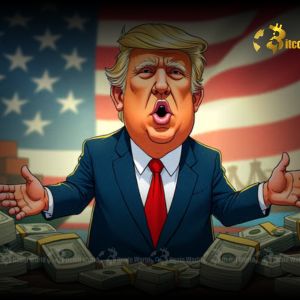BitcoinWorld US Dollar Faces Crucial Test as Trump’s Trade Deadline Looms In the dynamic world of global finance, events often ripple across markets, affecting everything from traditional stocks and bonds to the burgeoning cryptocurrency space. The recent marginal strengthening of the US Dollar , driven by the impending deadline for significant trade decisions by the Trump administration, serves as a prime example of this interconnectedness. For cryptocurrency enthusiasts and investors, understanding these macro-economic shifts is not just an academic exercise; it provides crucial context for market volatility, capital flows, and the broader sentiment that can influence digital asset valuations. As this pivotal moment approaches, the financial world watches closely, anticipating the next move in a geopolitical chess match that holds profound implications for currencies, trade, and the stability of the global economic order. Understanding the US Dollar’s Recent Strength Amidst Geopolitical Tensions The US Dollar , often seen as the world’s primary reserve currency and a safe haven during times of uncertainty, has shown a marginal but noticeable uptick as the deadline for President Trump’s trade decisions draws near. This strength is not accidental; it reflects a complex interplay of market forces, investor sentiment, and fundamental economic factors. One key indicator of the dollar’s performance is the Dollar Index (DXY), which measures the dollar’s value against a basket of six major currencies. A rising DXY indicates a strengthening dollar. Several factors contribute to this phenomenon: Safe-Haven Demand: In periods of geopolitical tension or economic uncertainty, investors tend to flock to assets perceived as safe. The US Dollar, backed by the world’s largest economy and a relatively stable political system, often fulfills this role. The looming trade deadline, with its potential for increased tariffs or retaliatory measures, creates precisely the kind of uncertainty that drives demand for the dollar. Relative Economic Performance: Despite global headwinds, the US economy might be perceived as relatively stronger compared to other major economies, particularly those heavily reliant on exports or facing their own internal challenges. This perception can attract capital flows into dollar-denominated assets. Interest Rate Differentials: While the Federal Reserve’s monetary policy has shifted towards easing, interest rate differentials with other major central banks can still play a role. If US rates, even if falling, remain more attractive than those in other major economies, it can support dollar demand. The term ‘marginally higher’ suggests that while the dollar has gained ground, it has not experienced a massive surge. This indicates that while the market acknowledges the risks associated with the trade deadline, there is also an element of caution or perhaps a belief that a resolution, even if temporary, might be found. This nuanced movement reflects a market weighing both the immediate risks and the potential for de-escalation or a ‘phase one’ deal. The Impending Trump Trade Deadline: A Critical Juncture At the heart of the dollar’s recent movements is the approaching deadline set by the Trump administration for new tariffs. This specific date, often a December deadline for additional tariffs on Chinese goods, has become a focal point for global financial markets. These tariffs, if implemented, would mark a significant escalation in the ongoing Trump Trade policies, which have been characterized by an ‘America First’ approach to international commerce. President Trump’s trade strategy has primarily aimed at reducing trade deficits, protecting domestic industries, and compelling trading partners to agree to more favorable terms for the United States. This has often involved the imposition of tariffs – taxes on imported goods – as a negotiating tool. The current deadline pertains to a tranche of goods that would significantly broaden the scope of tariffs, impacting a wider range of consumer products. The stakes are incredibly high. For the US, the decision could impact consumer prices, corporate profits, and the overall pace of economic growth. For China, it could further strain its manufacturing sector, employment, and economic stability. Beyond these two giants, the ripple effects would be felt globally, disrupting supply chains and impacting the growth prospects of nations reliant on international trade. The market is closely watching for several potential outcomes: Implementation of Tariffs: This would signal an escalation, likely leading to further market volatility and potential economic slowdown. Delay or Suspension of Tariffs: This would be seen as a de-escalation, providing relief to markets and potentially paving the way for further negotiations. A ‘Phase One’ Deal: A partial agreement, addressing some immediate concerns (e.g., agricultural purchases, intellectual property commitments) while leaving more complex issues for future talks, could offer temporary stability. Each scenario carries distinct implications for currency markets, equity markets, and the broader economic outlook. Unpacking the Trade War’s Intricacies and Its Evolution The current situation is a chapter in a prolonged and complex Trade War , primarily between the United States and China, that has reshaped global economic relations. What began with tariffs on steel and aluminum in 2018 quickly escalated into a tit-for-tat exchange of duties on hundreds of billions of dollars worth of goods. The core issues driving this conflict are multifaceted: Trade Imbalance: The large trade deficit the US has with China has been a consistent point of contention for the Trump administration. Intellectual Property Theft: Allegations of forced technology transfer and theft of intellectual property from US companies have been a major sticking point. State Subsidies: Concerns about Chinese state subsidies for its industries, which US officials argue create an unfair competitive advantage. Market Access: US companies often face restrictions or barriers to market access in China that Chinese companies do not face in the US. The evolution of the trade war has seen periods of intense negotiation interspersed with escalations. Each new round of tariffs or threats has sent jitters through financial markets, impacting investor confidence and business investment decisions worldwide. Here’s a simplified look at key milestones in the US-China trade conflict: Date Event/Action Impact March 2018 US imposes steel & aluminum tariffs Initial market jitters, retaliatory threats July 2018 US 25% tariffs on $34B Chinese goods; China retaliates Escalation, increased volatility Sept 2018 US 10% tariffs on $200B Chinese goods (rising to 25% Jan 2019) Broader impact on consumer goods, supply chains May 2019 US raises $200B tariffs to 25%; China retaliates Negotiations stall, increased market uncertainty Aug 2019 US announces tariffs on remaining $300B Chinese goods Market downturn, yuan depreciation Current Deadline for next tranche of tariffs approaches Heightened anticipation, dollar strength This ongoing conflict has forced companies to reassess their global supply chains, leading to diversification efforts and, in some cases, reshoring of production. It has also highlighted the fragility of a globally integrated economy when political tensions rise. Impact on the Forex Market : Volatility and Opportunities The Trade War , and particularly the looming deadline, has profound implications for the Forex Market . Currency valuations are highly sensitive to shifts in trade policy, economic outlooks, and investor risk appetite. Here’s how different currencies are reacting: USD/CNY (US Dollar vs. Chinese Yuan): This pair is at the epicenter. When trade tensions escalate, the Chinese yuan often depreciates against the dollar. This depreciation can be a deliberate policy move by Beijing to offset the impact of US tariffs, making Chinese exports cheaper in dollar terms. However, a rapidly weakening yuan can also signal economic stress within China and has implications for capital outflows. JPY (Japanese Yen): The Japanese Yen is another traditional safe-haven currency. During periods of global uncertainty and trade tensions, investors often buy the Yen, leading to its appreciation against riskier assets. This is because Japan has a large current account surplus and low domestic interest rates, making it an attractive destination for capital fleeing volatility. EUR (Euro): The Eurozone, heavily reliant on exports, is particularly vulnerable to a global slowdown caused by trade wars. Economic data from Germany, the Eurozone’s largest economy, often reflects the impact of trade tensions. A worsening trade outlook can weaken the Euro against the dollar and other safe-haven currencies. AUD/NZD (Australian Dollar/New Zealand Dollar): These commodity-linked currencies are highly sensitive to global growth and China’s economic health. As major exporters of raw materials to China, any slowdown in the Chinese economy due to trade tensions can directly impact demand for their exports, leading to depreciation of the AUD and NZD. GBP (British Pound): While primarily driven by Brexit developments, the Pound is also susceptible to broader global trade uncertainty. A global economic downturn exacerbated by trade wars would further complicate the UK’s post-Brexit trade agreements and economic outlook, adding pressure to the currency. Increased volatility is a hallmark of trade war periods in the forex market. Traders and investors must be prepared for sharp movements, as headlines related to trade negotiations or tariff implementations can trigger immediate reactions. This volatility, while challenging, also creates opportunities for those with robust risk management strategies and a deep understanding of the underlying drivers. Broader Implications for the Global Economy Beyond individual currencies, the Trump Trade policies and the ongoing Trade War cast a long shadow over the entire Global Economy . The cumulative effect of tariffs, retaliatory measures, and the pervasive uncertainty they create has tangible consequences for economic growth, investment, and employment worldwide. Slowing Global Growth: International organizations like the IMF and World Bank have repeatedly warned that trade tensions are a primary factor contributing to a slowdown in global economic growth. Reduced trade volumes, disrupted supply chains, and dampened business confidence translate directly into lower GDP forecasts. Business Investment Downturn: Companies facing uncertain trade environments are hesitant to make long-term investments in new factories, equipment, or research and development. This ‘wait-and-see’ approach stifles innovation and future growth potential. Supply Chain Disruptions: Global supply chains, built over decades for efficiency and cost-effectiveness, are being re-evaluated and restructured. This process is costly, time-consuming, and can lead to higher prices for consumers as companies seek alternative sourcing or manufacturing locations. Consumer Confidence and Spending: The specter of higher prices due to tariffs, combined with job insecurity stemming from economic slowdowns, can erode consumer confidence. Reduced consumer spending, a major driver of economic growth in many countries, can further exacerbate economic challenges. Central Bank Responses: Faced with trade-induced headwinds, central banks worldwide have responded by cutting interest rates and, in some cases, resuming quantitative easing programs. While intended to stimulate growth, these measures also highlight the severity of the economic threats posed by trade tensions and can limit policy space for future downturns. Impact on Emerging Markets: Many emerging economies are deeply integrated into global supply chains and are highly dependent on international trade and foreign investment. The trade war can lead to capital flight, currency depreciation, and reduced demand for their exports, pushing them towards economic instability. The interconnectedness of the modern global economy means that a trade dispute between two major players like the US and China has far-reaching consequences, affecting industries and individuals far beyond their borders. The potential for a prolonged trade war or a significant escalation poses a material risk to the stability and prosperity of nations worldwide. Navigating Uncertainty: Actionable Insights for Investors In an environment shaped by trade tensions and currency fluctuations, investors need a clear strategy. While the immediate focus is on the US Dollar and the impending Trump Trade deadline, the principles for navigating such uncertainty remain consistent. Diversification is Key: Do not put all your eggs in one basket. Diversify across different asset classes (equities, bonds, commodities, and even alternative assets like cryptocurrencies, with careful consideration of their risk profiles) and geographical regions. This can help cushion your portfolio against shocks in any single market. Stay Informed, But Avoid Overreacting: Monitor reliable news sources for developments on trade talks and economic indicators. However, avoid making impulsive decisions based on every headline. Markets often overreact to news in the short term. Focus on Fundamentals: For individual investments, continue to focus on the underlying fundamentals of companies or assets. Strong balance sheets, robust business models, and adaptability to changing trade landscapes are crucial. Consider Safe-Haven Assets: While the US Dollar is a safe haven, other assets like gold, the Japanese Yen, or even high-quality government bonds can also serve this purpose during periods of heightened risk. Risk Management: Implement strict risk management protocols. This includes setting stop-loss orders, managing position sizes, and not over-leveraging. Understand your personal risk tolerance and stick to it. Long-Term Perspective: While short-term volatility can be unsettling, a long-term investment horizon often helps to ride out periods of market turbulence. Economic cycles and geopolitical events are part of the landscape, but economies tend to recover and grow over time. For those interested in cryptocurrencies, it’s worth noting that while often seen as uncorrelated, digital assets are not entirely immune to macro-economic forces. Extreme dollar strength or a significant global economic downturn could influence investor appetite for riskier assets, including crypto. Conversely, some view Bitcoin as a potential hedge against traditional financial system instability, though its volatility remains high. Conclusion The marginal rise of the US Dollar as President Trump’s trade deadline approaches underscores the intricate dance between geopolitics, economic policy, and financial markets. The ongoing Trade War , driven by the administration’s Trump Trade agenda, continues to be a dominant theme, injecting uncertainty and volatility into the Forex Market and casting a long shadow over the prospects for the Global Economy . While the immediate outcome of the trade deadline remains uncertain, its potential ramifications for currencies, international trade, and global growth are undeniable. Investors and market participants must remain vigilant, understanding that these macro-economic shifts are not isolated events but interconnected forces that demand a holistic and informed approach to navigating the complex landscape of modern finance. Staying abreast of developments and applying sound investment principles will be paramount in the weeks and months ahead. To learn more about the latest Forex market trends, explore our article on key developments shaping the US Dollar and global trade liquidity. This post US Dollar Faces Crucial Test as Trump’s Trade Deadline Looms first appeared on BitcoinWorld and is written by Editorial Team


















